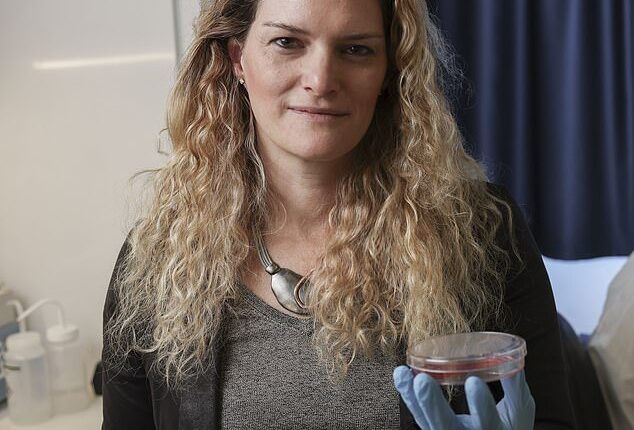People always ask me if the aim of my work is one day to get rid of men,’ says biologist Nitzan Gonen. It doesn’t seem an unreasonable query, given that, in a world first, Dr Gonen recently managed to grow miniature versions of male testicles in a laboratory.
And although they were grown from cells extracted from mice, any day now Dr Gonen will shift to using human cells.
The goal? Ultimately to develop cells in the laboratory that are capable of producing human sperm.
This isn’t a distant dream. Dr Gonen, who heads the Sex Determination Laboratory at Bar-Ilan University in Israel, hopes this could be a reality within five years.
And what is remarkable is how she intends to go about it: using stem cells isolated from a miniature flake of skin taken from a man’s arm.

Biologist Nitzan Gonen, who heads the Sex Determination Laboratory at Bar-Ilan University in Israel, aims to help men who can’t produce sperm
Dr Gonen, a mother of four, says her work will help those men who can’t produce sperm — for whom currently there is no other way to father a child — rather than being used as a way to make babies without a man.
It will also help further research into how to safeguard the health of sperm, the need for which is becoming ever more pressing.
‘Male fertility is in crisis, and unless we do something about it the human race is going to be in a total mess,’ is how Christopher Barratt, a professor of reproductive medicine at Dundee University and a member of the World Health Organisation’s board for semen analysis, sums up the situation.
His grim analysis is based on studies such as one that found that between 1973 and 2018 sperm concentration (the number of sperm per unit of semen) fell by 1.2 per cent a year — and after 2000, by an alarming 2.6 per cent a year, according to a review of more than 200 studies published in the journal Human Reproductive Update in 2022.
A fertile man produces 66 million sperm per millilitre of semen on average — a man is said to be infertile if he produces 16 million per millilitre, according to World Health Organisation definitions, and the number affected appears to be increasing.
‘Not only is the sperm count dropping — that is, the total number of sperm per ejaculate — but so too is the sperm concentration, or the number of sperm per millilitre and the quality of sperm [ie factors such as how well they move],’ says Professor Barratt.
‘We used to say that in 99 per cent of cases, if a couple were struggling to conceive, then it was usually due to a problem with the woman; but now we say that it’s as likely to be due to the man,’ he adds.
Professor Barratt says around 7 per cent of men in the UK have fertility problems, although that looks certain to rise.
‘In the last 20 to 30 years, the birth rate has reduced significantly largely due to social reasons, such as people delaying having children.

In the last 20 to 30 years, the birth rate has reduced significantly largely due to social reasons, such as people delaying having children
‘But the effect of the drop in sperm count is going to kick in soon — and the challenge is that we have no treatment for it,’ says Professor Barratt.
‘Male fertility is totally under-appreciated and under researched, and there is a genuine cause for concern.’
Judging how deep the crisis is is not straightforward, as methods for analysing sperm counts have changed over the decades and some experts, such as Allan Pacey, a professor of andrology at the University of Manchester, say that not all the data show sperm counts are falling.
He co-authored work published in June in the journal Human Reproduction based on more than 6,000 sperm donors in Denmark that showed no change in their sperm count between 2017 and 2022 — although the research did show that the concentration and motility (sperm’s ability to swim) declined by 16 per cent and 22 per cent respectively between 2019 and 2022.
Yet even he agrees that ‘male fertility is in crisis’ — although for other reasons we will come to.
Sperm originates as ‘germ’ cells in minute tubules in the testicles, which are ‘nursed’ by Sertoli cells. These ‘nurse’ cells send chemical messages and nourish the germ cells to help them mature into sperm cells — a process that takes about 74 days.
‘Germ cells are just like a pebble or ball of cells and undergo this metamorphosis almost like a tadpole does, to develop a tip and a tail,’ says Professor Barratt. ‘No other cells in the body undergo as big a degree of change as a germ cell that becomes a sperm.’
Leydig cells, outside the tubules, help this along by pumping out the hormone testosterone.
It is damage to the supportive Sertoli cells that is thought to underpin much of the apparent fall in male fertility.
One theory is that, during pregnancy, environmental factors — such as exposure to plastics or hormone-disrupting compounds found in numerous household items — damage the development of the testicles and these cells.
Other suggestions are that the minute particles of air pollution, called PM2.5, cause the damage.
One study, involving 33,876 men in or around Shanghai in China whose female partners were seeking assisted help with conception, measured air pollution levels across the city in the run-up to the men giving a sperm sample.

Dr Gonen said she received emails from men around the world who were struggling to father a child, all wanting to know if she could help them
The results, published in the journal JAMA Network in 2022, found that the higher the levels of PM2.5 during the 90-day run-up to them giving a sample, the lower the total sperm and their ‘motility’.
‘One thought is these factors [such as air pollution and minute plastic particles] reduce the number of Sertoli cells and/or make those cells that are there less efficient, so that they can’t help nurture as many germ cells into sperm,’ says Professor Barratt.
It may be that these factors trigger inflammation and it is this that does the damage.
Around 1 per cent of men and 10-15 per cent of infertile men have a more intense problem — azoospermia, meaning they have no sperm in their semen at all.
For some men that will be due to a physical obstruction in the reproductive ducts due to, for example, injury or infection — and in some cases sperm can be extracted from the testes.
But for others it can stem from damage to the sperm-making cells in the testes, as a result of genetics — for example, exposure to radiation or chemotherapy.
While men with a low sperm count may still be able to father children with the help of in vitro fertilisation (IVF, where sperm is mixed with their partner’s eggs in a Petri dish in a lab), or intracytoplasmic sperm injections (ICSI, where a sperm is injected directly into an egg), for those with no sperm this isn’t an option. And it is these kind of cases, in particular, who might benefit from Dr Gonen’s work.
The miniature testicles she’s produced are a form of organoid — essentially, a microscopic version of an organ — with the vital components, Leydig, Sertoli and germ cells.
Scientists around the world have already been able to produce a range of organoids — from gallbladders to hearts and brains — with the aim of using them for research and, in some cases, with the hope of one day using them as replacement organs.
‘Each testicle organoid is extremely small — less than a millimetre,’ explains Dr Gonen. ‘It’s like a miniature functional unit of the testicle rather than the testicle as a whole.
‘But we are just including the elements we need to make sperm. We don’t need full-blown size units.’
It took six years experimenting with different processes before Dr Gonen’s team hit on one that worked.

Scientists around the world have already been able to produce a range of organoids – from gallbladders to hearts and brains – with the aim of using them for research and, in some cases, with the hope of one day using them as replacement organs
The successful approach involved taking the testes of five-day-old mice and isolating the Sertoli, germ and Leydig cells.
‘Normally, if you put these cells into a Petri dish they would just be dead,’ says Dr Gonen.
But when Dr Gonen added hormones and growth medium to try to replicate the environment of the testes, the team had a ‘wow’ moment. ‘Within days, we could see that what had started as a collection of cells were forming into structures similar to those in the testes — cells assembled into tubules and the germ cells were encapsulated in the tubules and the Leydig cells were outside of the tubules — just as they should be.’
After the results were published in January in the International Journal of Biological Sciences, it made international news and Dr Gonen received emails from men around the world who were struggling to father a child, all wanting to know if she could help them.
But the question was if these organoids worked like testicles.
The answer, at least in part, was yes. ‘We have initial indications that the germ cells can enter meiosis,’ says Dr Gonen. This is the process by which germ cells halve the DNA in their cells, just prior to changing shape into a sperm with a head and tail.
All of which indicated that they had made sperm. ‘But we can’t confirm that yet — we need to run more tests,’ says Dr Gonen.
They managed to keep the organoids alive for nine weeks, after which they died naturally. Usually, in mice, sperm production takes 34 days, so in principle it was long enough for sperm to be produced.
Dr Gonen is now working with a hospital in Jerusalem to try to generate organoids from frozen tissue from the testicles of children undergoing chemotherapy.
As in the UK, children in Israel about to have chemotherapy (or other treatment that may leave them infertile) are offered the chance to have minute samples of their testes removed and frozen.
This is done in the hope that by the time they want a family, technology will have moved on so that their stored biopsies can be used to make sperm.
‘But at the moment there is nothing we can do with these biopsies,’ says Dr Gonen.
She adds: ‘Around 80 per cent of children survive childhood cancer, but half of them will lose their fertility.
‘In girls, you can remove a slice of ovary and freeze it, and when she is older transplant it back — and you can get eggs that you can use.
‘For boys in the same position, at the moment [if prepubescent, they’re too young to produce sperm] there is no solution and it can have a big impact.’
The hope is they can make an organoid from the frozen sample capable of producing sperm.
Currently, says Dr Gonen, the team is practising freezing and unfreezing mouse testes ‘to perfect every step of the technique before we move on to the children’s tissue’.
The organoids will be grown in a medium that will be changed in order for the miniature testicles to mature and go through a type of adolescence — ‘to try to recreate exactly what happens in the body’.
Within five years, Dr Gonen hopes she will have perfected the technique, enabling her to grow miniature testicles from a minuscule patch of skin taken from an infertile man.
The skin cells would first be turned into pluripotent stem cells — master cells that can turn into just about any cell in the body. The idea is these will then be turned into the germ, Leydig and Sertoli cells needed to make the mini organoids.
There are other teams trying to produce laboratory-made sperm. In 2016, a team in China managed to create a very primitive form of sperm — spermatids (without a head or tail). These were created using stem cells from mice, and when injected into mouse eggs, resulted in the birth of six mouse babies, according to the researchers writing in the journal Cell Stem Cell.
And in 2021, a team from the University of Georgia reported in the journal Fertility and Sterility Science that they had produced spermatids using stem cells derived from monkeys. These spermatids seemed capable of fertilising an egg.
There are obviously ethical concerns about such work. For example ‘there will need to be very strict criteria for storage and tracking’, says Professor Suks Minhas, a consultant urologist and andrologist at Imperial College London.
But the consensus is that Dr Gonen’s research is exciting.
‘It’s fantastic, but it’s very complicated and it’s going to take time to perfect,’ says Professor Barratt. ‘I think within the next five or ten years we will at least be able to produce sperm-like cells in the test tube — and that in itself will help improve our research into male infertility.’
While making sperm in a lab may be some way off, many experts believe a big step forward to improve male fertility could be achieved right now, by improving awareness about the role of men’s age.
As Professor Pacey explains: ‘We are in a male fertility crisis because men are leaving it until later in life to try for children [see box, above] and partly because reproductive medicine is focused on women not men.
‘Men have to share some of the blame for this, and I think medicine also has to share some of the blame.’
Others argue that there is a pressing need for more research into the underlying causes of male infertility — and that offering assisted reproduction options may be ‘bypassing normal selection’ and perpetuating the problem, which may be genetic.
Professor Joris Veltman, a geneticist at the University of Newcastle, points out that ‘some research has found that children born via ICSI have a higher infertility rate than the rest of the population’.
He published research in 2022 which identified genetic faults connected to infertility that then made male children infertile — and in 50 per cent of cases that genetic fault could directly be passed on to offspring.
‘When most fertility clinics see an infertile man, they don’t think, ‘why is he infertile?’; they think, ‘let’s use artificial reproductive technologies to help him to conceive’,’ he says.
‘With the majority of men, we don’t investigate what the underlying cause is. That means we don’t know what we are handing on.’
Meanwhile, the question remains: Will the human race ever be able to do without men?
‘No, definitely not,’ laughs Dr Nitzan Gonen. ‘We need their chromosomes — we have to stick with them.’









